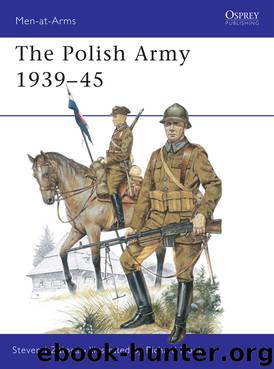The Polish Army 1939–45 by Steven J. Zaloga

Author:Steven J. Zaloga
Language: eng
Format: epub
Tags: The Polish Army 1939–45
ISBN: 9781472804471
Publisher: Bloomsbury Publishing
3in. mortar crew of 3rd Carpathian Rifle Div. photographed near Mt Croce, 11 March 1944. Note the divisional patch, which was often removed in the front line: halved white over red, with a green pine tree superimposed. The battledress and equipment are standard British issue.
Near Montenero, 3 March 1944: Universal carriers of 3rd Pltn., HQ Coy., 3rd Bn., 1st Bde., 3rd Carpathian Rifle Div. advance with caution. The platoon commander carries a Thompson, though apparently not with enough tension to disturb the ash on his cigarette! The lead carrier mounts the .55 Boys AT rifle.
At the conclusion of the war, the Polish Army in the West numbered some quarter of a million soldiers. Besides the units which had seen combat there were a number of new divisions and tank brigades ready to go into action had the war continued. The Polish Army was more than a symbolic force, as was the case with most of the émigré contingents. It fought in many of the major campaigns of the war, and to draw attention to their contributions the Poles often chose some of the toughest assignments. The Polish contribution is all the more remarkable in view of the epic journeys many of the soldiers undertook to escape from occupied Poland to serve in the exile army. In the end their sacrifices were largely in vain. By 1945 it was clear that the United States and Britain had ceded half of pre-war Poland to the Soviet Union in exchange for a smaller amount of land to be taken from Germany. They had agreed to the formation of a sham coalition government which fronted for a Communist takeover. As the Soviet Union would never consider allowing the Polish divisions to return as a whole to Poland, the units remained together until 1947, when it was evident that their further existence would be futile. The new Communist government of Poland offered to allow individual Polish soldiers to return, but only a fraction did so. After five years on foreign soil some soldiers could not bear to be parted from their families and country any longer, and returned in spite of their misgivings. Many of these unfortunate men ended up in prison camps, from which most were not freed until 1956. The larger portion of the soldiers settled in Britain, but there is hardly a major city in all of North and South America and Australia without its own small community of Polish Army veterans.
1 Soviet security police.
Download
This site does not store any files on its server. We only index and link to content provided by other sites. Please contact the content providers to delete copyright contents if any and email us, we'll remove relevant links or contents immediately.
| Africa | Americas |
| Arctic & Antarctica | Asia |
| Australia & Oceania | Europe |
| Middle East | Russia |
| United States | World |
| Ancient Civilizations | Military |
| Historical Study & Educational Resources |
Flight by Elephant(1483)
The Rise and Fall of the Third Reich: A History of Nazi Germany by William L. Shirer(1384)
Unbroken: A World War II Story of Survival, Resilience, and Redemption by Hillenbrand Laura(1102)
German submarine U-1105 'Black Panther' by Aaron Stephan Hamilton(1018)
Last Hope Island by Lynne Olson(937)
A Bridge Too Far by Cornelius Ryan(929)
The Victors - Eisenhower and His Boys The Men of World War II by Stephen E. Ambrose(904)
War by Unknown(904)
The Guns at Last Light: The War in Western Europe, 1944-1945 by Rick Atkinson(888)
Rogue Heroes: The History of the SAS, Britain's Secret Special Forces Unit That Sabotaged the Nazis and Changed the Nature of War by Ben Macintyre(884)
0060740124.(F4) by Robert W. Walker(872)
The Hitler Options: Alternate Decisions of World War II by Kenneth Macksey(865)
The Railway Man by Eric Lomax(847)
All the Gallant Men by Donald Stratton(815)
Hitler's Vikings by Jonathan Trigg(809)
A Tragedy of Democracy by Greg Robinson(801)
Churchill's Secret War by Madhusree Mukerjee(799)
Hitler's Armies by Chris McNab(782)
We Die Alone: A WWII Epic of Escape and Endurance by David Howarth & Stephen E. Ambrose(747)
